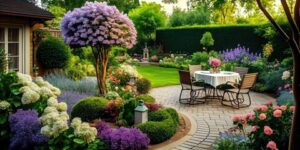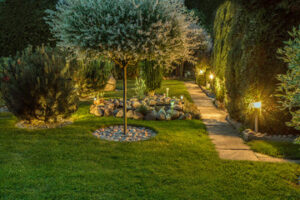Kentucky Landscaping is more than just beautifying your yard; it involves hardscaping elements like paving and walls. From fences to retaining walls, these structures serve a purpose and should be adequately maintained to ensure proper flow of your landscape and reduce tripping hazards.

One trend that has been fueling the industry this year is multi-season functionality. Clients are asking for distinct dining, living, and gathering spaces to accommodate family and friends, even in the winter.
Your home’s exterior sets the stage for what’s inside, and landscaping curb appeal is an important first impression that can boost your property’s value. Whether you’re planning to sell your house in the future or simply want it to look nicer for visitors, there are plenty of projects you can do that will give your home a dressed-to-impress appearance without busting the bank or gobbling up endless weekends.
The size of your lawn, the shape of your driveway, and the color of your home’s trim are all factors in curb appeal, but it’s also possible to make a dramatic impact with just a few carefully chosen plants and hardscape features. A limited palette of plants works well for a modern garden, while a traditional or country-style home will look good with a more symmetrical planting plan. Plants that work best for front yard landscaping include hydrangea, azalea, and various boxwood varieties, as well as roses.
Pavers, steps, and low grasses can all add to your home’s visual appeal. Oversized pavers arranged in even gaps have a geometric appeal that’s especially striking when set off by natural materials and an array of plants that grow up from and around them.
Curb appeal is not just about making your house look better, it’s also about creating a welcoming and attractive entryway. An inviting entrance will help guests feel at home, and it will encourage people to stop by for a chat or to take a walk around the neighborhood. Adding a few small details like a flower-filled window box or a rocking chair to your porch is a great way to create a welcoming atmosphere.
A well-groomed front yard can make your entire house look a lot better, and it’s usually a quick and easy project that anyone can do. Mowing the lawn regularly, edging your flower beds, and using mulch that’s been professionally installed will all help your property look its best. For an extra-special touch, consider painting your door and shutters a bright color that complements your landscaping. These simple upgrades can make your home’s exterior look new again, and they’ll definitely get the neighbors talking.
Privacy
There are a number of reasons to do landscaping around your home, from creating visual appeal to improving privacy. While many homeowners associate a landscape with beautiful plants and colors, it also includes practical benefits such as shade, erosion control and habitat for wildlife.
When it comes to privacy, there are a variety of ways to increase your level of seclusion without a fence. Clever landscape design tricks, such as staggered plant material and garden accents, can go a long way in reducing prying eyes. Other structures, such as a pergola filled with climbing vines, can help screen out views and create intimate outdoor spaces.
Evergreens are great privacy landscaping options for year-round screening, as they tend to be less restrictive than municipal ordinances that limit fence heights. Fast-growing shrubs like Italian cypress and arborvitae can offer privacy quickly, while low-maintenance privet hedges are a quick solution for blocking sight lines from a backyard patio to a neighbor’s yard.
Another way to add privacy to a yard is with a retaining wall. Not only do these structures provide a functional purpose, but they can be used as an opportunity to elevate your garden aesthetic with a wide range of options from incorporating decorative stones to cladding the walls with flowering perennials and annuals.
Adding a gate to your home is an easy, cost-effective privacy landscaping idea that allows you to open or close the gate at any time you like. This prevents nosy neighbors from wandering onto your property and interrupting conversations or interrupting your family’s evening dinners outside.
A gazebo is an ideal structure for creating a secluded nook, offering privacy with the roof and sides but still allowing light and breezes to pass through. Fill the gazebo with flowers and plants that thrive in shade to add beauty and a welcoming fragrance.
Landscaping can do more than just raise your property value, it can also improve your health and well-being by reducing stress, improving air quality and boosting physical activity. Surrounding your home with beautiful landscaping adds a polished touch that makes the space more inviting and comfortable to spend time in.
Eco-Friendliness
In a time when environmental degradation is becoming more widely recognized, it’s important to consider how your landscaping can impact our planet. This means not just avoiding invasive plants and using water-efficient irrigation systems but also choosing species that are native or have few pest problems, so they don’t require a lot of chemicals to grow well and thrive.
It also means minimizing your home’s energy use by incorporating drought tolerant species, working with windbreaks and planting trees that will help regulate your property’s temperature. In addition, a garden designed for ecological health can also be a great way to reduce your exposure to pollutants such as air and noise pollution, especially if you live in the city.
Eco-friendly landscaping practices are more than a trend or a fad. They’re a profound commitment to making conscious choices that prioritize the health of our ecosystems and, by extension, ourselves. In the backyard, it can mean choosing native plants for your landscape design, eliminating lawn chemicals and replacing it with a meadow or vegetable garden that provides food for wildlife and humans. It can mean mulching and composting your vegetable scraps and grass clippings, and it can mean creating a habitat for birds, bees and butterflies.
In the Lake Wilcox neighbourhood, it can mean incorporating a rain garden or native vegetation to absorb stormwater, helping to prevent runoff and reducing the amount of nutrients carried into our lakes and streams. It can also be a great way to connect wildlife corridors and provide additional natural habitat for animals in urbanized areas.
If you’re thinking about giving your yard an eco-friendly makeover, there are many ways to get started. For example, start a compost bin for your veggie scraps and grass clippings to generate valuable fertilizer, and consider installing an irrigation system that will keep your garden soil moist without wasting water. And don’t forget to plant trees and shrubs for shade, which will help keep the soil cooler and reduce your energy costs in the summer.
Wildlife
Wildlife habitat is under threat due to human activity, and wildlife species are being pushed into ever-shrinking wilderness areas. Landscaping with native plants offers a way for people to help create wildlife-friendly environments that provide safe places for birds, butterflies, insects and animals to hide and raise their young.
Wildscaping is a term that refers to a garden designed to support wildlife while also being appealing to the human eye. Wildlife-friendly landscaping incorporates native plants that are adapted to the climate, soil and rainfall of a region. These plant species have co-evolved with the animals, fungi and bacteria that live in an ecosystem with them and require minimal maintenance from the homeowner.
The most basic requirements for attracting wildlife to a landscape include food, water and shelter. Food includes both the berries and seeds of many species of trees, shrubs, and flowering plants. Plants should be selected that bear fruit or produce a nutrient-rich bulb in each season, and food sources should be spread throughout the landscape for consistency and to reduce competition between plants.
Water is essential for all wildlife, and providing a water source for wild animals is one of the easiest ways to attract wildlife to a yard. A natural stream, pond, waterfall or birdbath are all good options. Many wild animals will travel long distances for a drink of fresh water, and the right spot in the yard can become a favorite resting or nesting area.
Cover is important for a lot of wild animals, and it can be provided by brush piles, rock walls, logs, and stumps. This is especially important in new wildscapes where the trees and shrubs have not yet matured to offer natural cover.
Successful wildlife gardens must be able to serve the needs of wild animals through all four seasons. Plants that are a reliable food source year-round should be included in the landscape to ensure that animals have something to eat all the time. Finally, the plants should be arranged so that the food, water and cover elements are connected by corridors of cover to cut down on predator mortality as animals move between the different habitat components.
